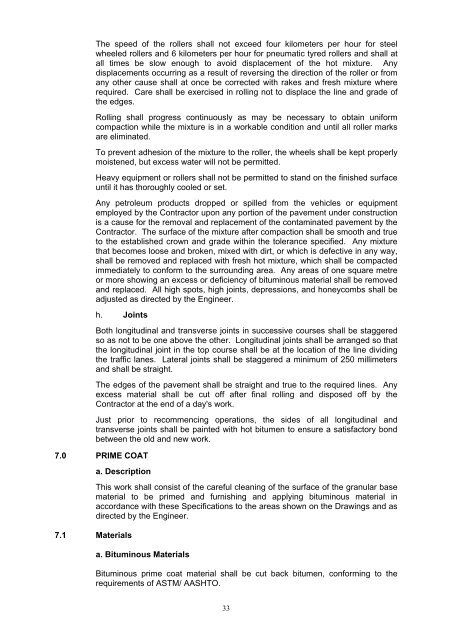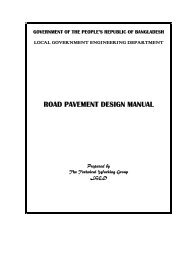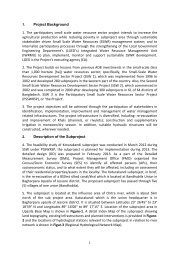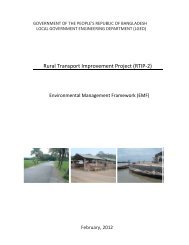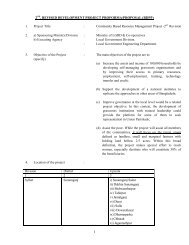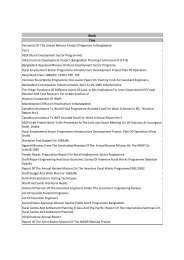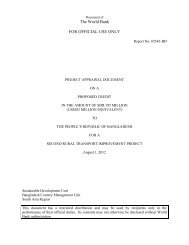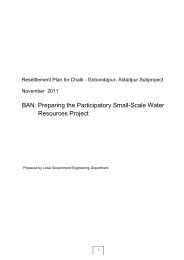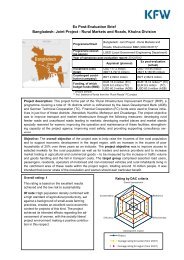Pavement Design Catalogue - LGED
Pavement Design Catalogue - LGED
Pavement Design Catalogue - LGED
Create successful ePaper yourself
Turn your PDF publications into a flip-book with our unique Google optimized e-Paper software.
The speed of the rollers shall not exceed four kilometers per hour for steel<br />
wheeled rollers and 6 kilometers per hour for pneumatic tyred rollers and shall at<br />
all times be slow enough to avoid displacement of the hot mixture. Any<br />
displacements occurring as a result of reversing the direction of the roller or from<br />
any other cause shall at once be corrected with rakes and fresh mixture where<br />
required. Care shall be exercised in rolling not to displace the line and grade of<br />
the edges.<br />
Rolling shall progress continuously as may be necessary to obtain uniform<br />
compaction while the mixture is in a workable condition and until all roller marks<br />
are eliminated.<br />
To prevent adhesion of the mixture to the roller, the wheels shall be kept properly<br />
moistened, but excess water will not be permitted.<br />
Heavy equipment or rollers shall not be permitted to stand on the finished surface<br />
until it has thoroughly cooled or set.<br />
Any petroleum products dropped or spilled from the vehicles or equipment<br />
employed by the Contractor upon any portion of the pavement under construction<br />
is a cause for the removal and replacement of the contaminated pavement by the<br />
Contractor. The surface of the mixture after compaction shall be smooth and true<br />
to the established crown and grade within the tolerance specified. Any mixture<br />
that becomes loose and broken, mixed with dirt, or which is defective in any way,<br />
shall be removed and replaced with fresh hot mixture, which shall be compacted<br />
immediately to conform to the surrounding area. Any areas of one square metre<br />
or more showing an excess or deficiency of bituminous material shall be removed<br />
and replaced. All high spots, high joints, depressions, and honeycombs shall be<br />
adjusted as directed by the Engineer.<br />
h. Joints<br />
Both longitudinal and transverse joints in successive courses shall be staggered<br />
so as not to be one above the other. Longitudinal joints shall be arranged so that<br />
the longitudinal joint in the top course shall be at the location of the line dividing<br />
the traffic lanes. Lateral joints shall be staggered a minimum of 250 millimeters<br />
and shall be straight.<br />
The edges of the pavement shall be straight and true to the required lines. Any<br />
excess material shall be cut off after final rolling and disposed off by the<br />
Contractor at the end of a day's work.<br />
Just prior to recommencing operations, the sides of all longitudinal and<br />
transverse joints shall be painted with hot bitumen to ensure a satisfactory bond<br />
between the old and new work.<br />
7.0 PRIME COAT<br />
a. Description<br />
7.1 Materials<br />
This work shall consist of the careful cleaning of the surface of the granular base<br />
material to be primed and furnishing and applying bituminous material in<br />
accordance with these Specifications to the areas shown on the Drawings and as<br />
directed by the Engineer.<br />
a. Bituminous Materials<br />
Bituminous prime coat material shall be cut back bitumen, conforming to the<br />
requirements of ASTM/ AASHTO.<br />
33


